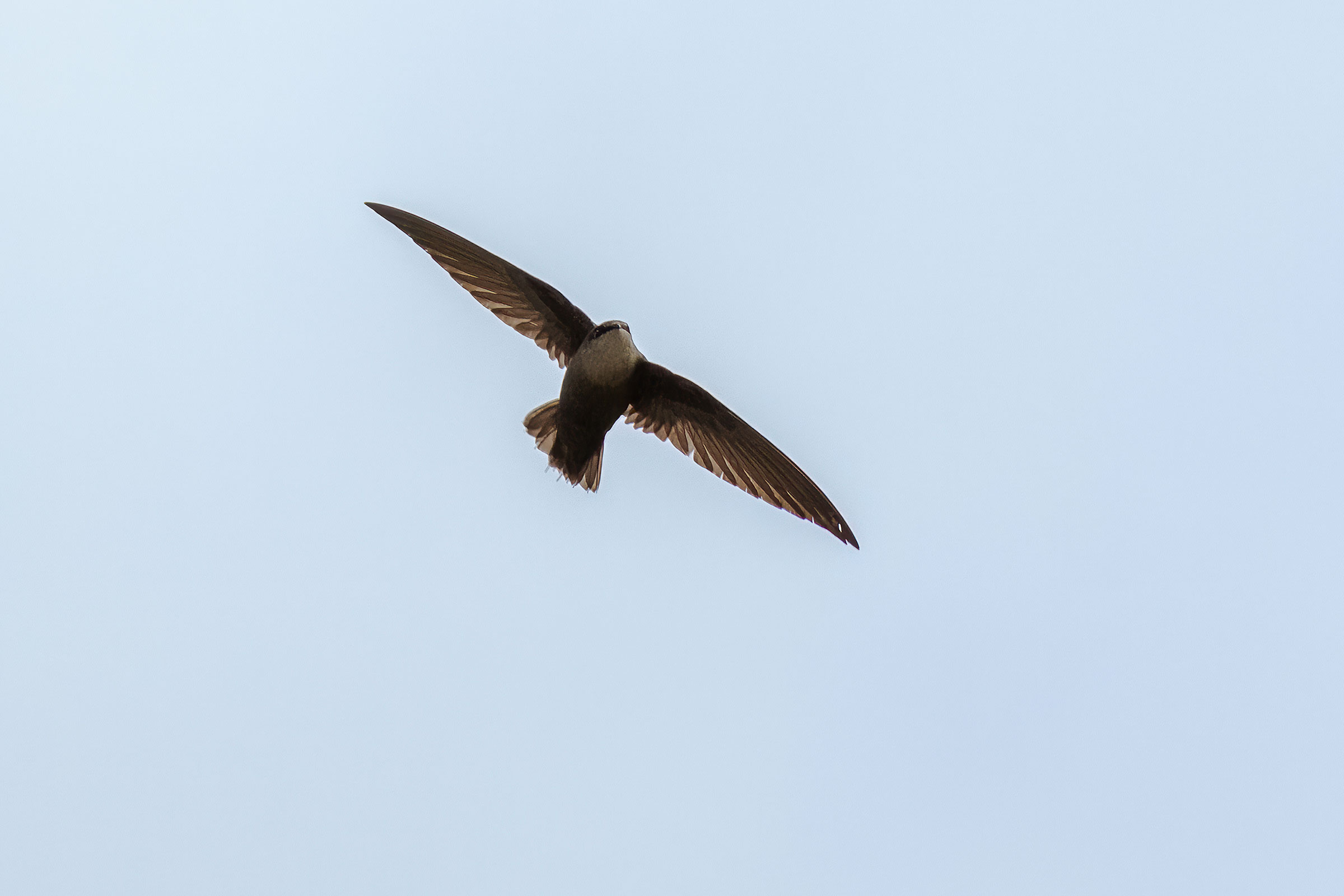Introduction
A “cigar” with wings, the outline of the Chimney Swift is easy to recognize flying through Virginia’s skies. Chimney Swifts in Virginia are concentrated in cities and suburban areas, where they use their saliva to stick a half-round nest of twigs to the insides of chimneys. Step outside on a summer evening near Richmond, Winchester, Blacksburg, or nearly any developed area and you are likely to see Chimney Swifts spiraling toward their nighttime roosts (Steeves et al. 2020).
Breeding Distribution
Chimney Swifts occur throughout Virginia, with the highest likelihood of occurring in cities and suburban areas that have chimneys or other human structures (e.g., abandoned buildings and silos) (Figure 1). Their likelihood of occurring increases as the amount of developed and agricultural lands and edge habitat increases in a block. They are slightly less likely to occur in areas with a greater diversity of habitat types.
Between the First and Second Atlases (Figures 1 and 2), Chimney Swift likelihood of occurrence remained unchanged and generally high across the state (Figure 3).

Figure 1: Chimney Swift breeding distribution based on probability of occurrence (Second Atlas, 2016–2020). This map indicates the probability that this species will occur in an Atlas block (an approximately 10 mi2 [26 km2] survey unit) based on environmental (including habitat) factors and after adjusting for the probability of detection (variation in survey effort among blocks).
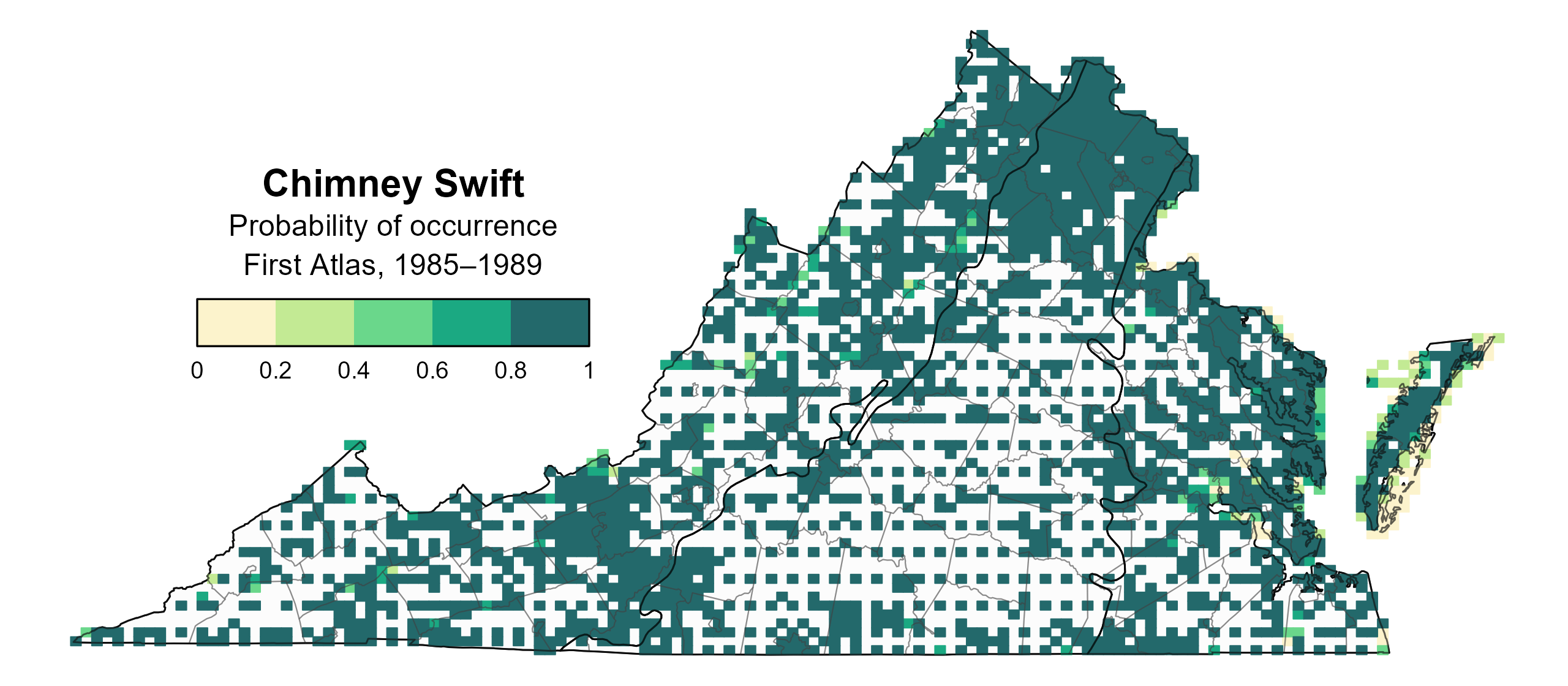
Figure 2: Chimney Swift breeding distribution based on probability of occurrence (First Atlas, 1985–1989). This map indicates the probability that this species will occur in an Atlas block (an approximately 10 mi2 [26 km2] survey unit) based on environmental (including habitat) factors and after adjusting for the probability of detection (variation in survey effort among blocks). Blocks in white were not surveyed during the First Atlas and were not modeled.
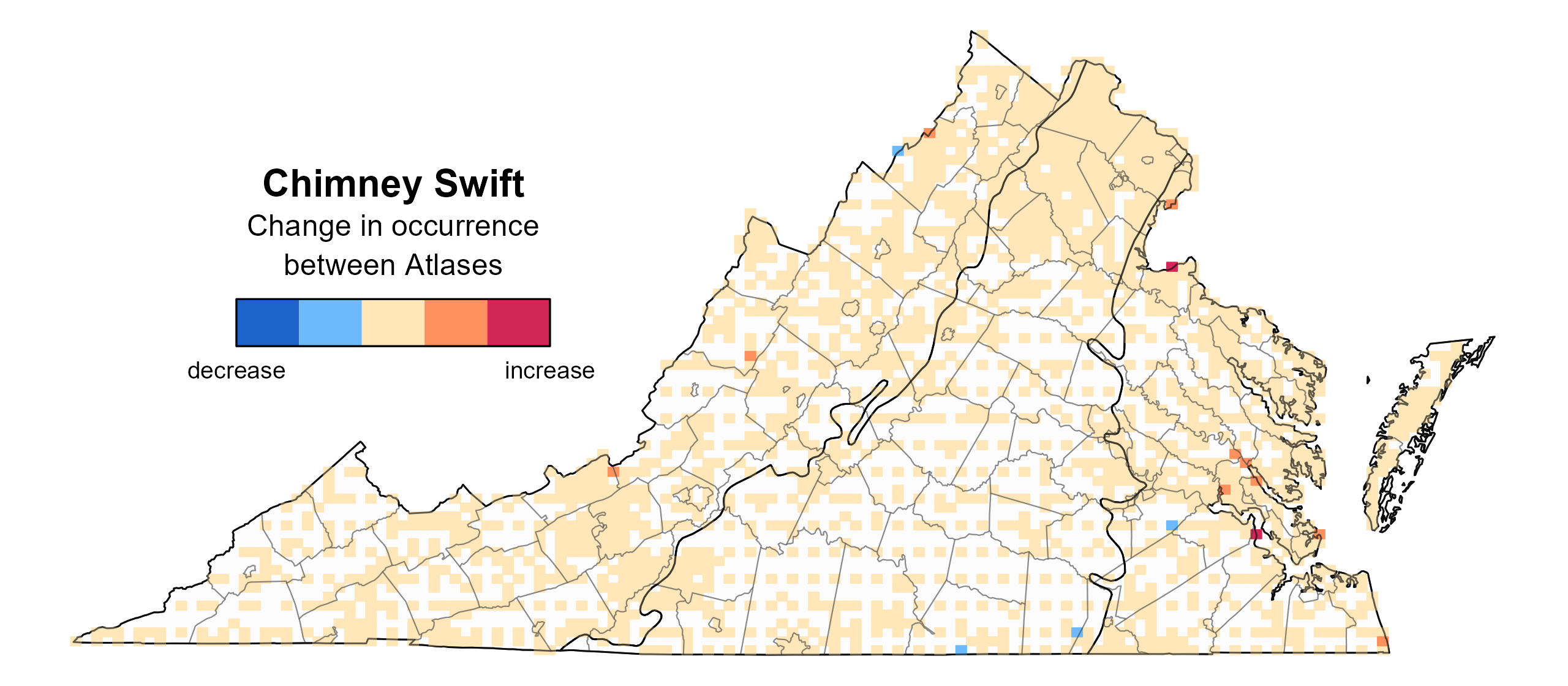
Figure 3: Chimney Swift change in breeding distribution between Atlases (1985–1989 and 2016–2020) based on probability of occurrence. This map indicates the change in the probability that this species will occur in a block (an approximately 10 mi2 [26 km2] survey unit) between Atlas periods. Blocks with no change (tan) may have constant presence or constant absence. Blocks in white were not surveyed during the First Atlas and were not modeled.
Breeding Evidence
Chimney Swifts were confirmed breeders in 156 blocks and 66 counties and found to be probable breeders in an additional 36 counties (Figure 4). Although breeding observations were recorded throughout the state, clusters occurred in more urban areas; however, this effect may also have been due to increased effort in those areas. Breeding observations also were recorded throughout the state in the First Atlas (Figure 5).
Breeding activity began in early May with documentation of occupied nests (May 8 – August 11) and continued through mid-August with observations of recently fledged young (Figure 6). Most breeding was confirmed through observations of occupied nests and nests with young (May 22 – August 14). For more general information on the breeding habits of this species, please refer to All About Birds.

Figure 4: Chimney Swift breeding observations from the Second Atlas (2016–2020). The colored boxes illustrate Atlas blocks (approximately 10 mi2 [26 km2] survey units) where the species was detected. The colors show the highest breeding category recorded in a block. The numbers within the colors in the legend correspond to the number of blocks with that breeding evidence category.
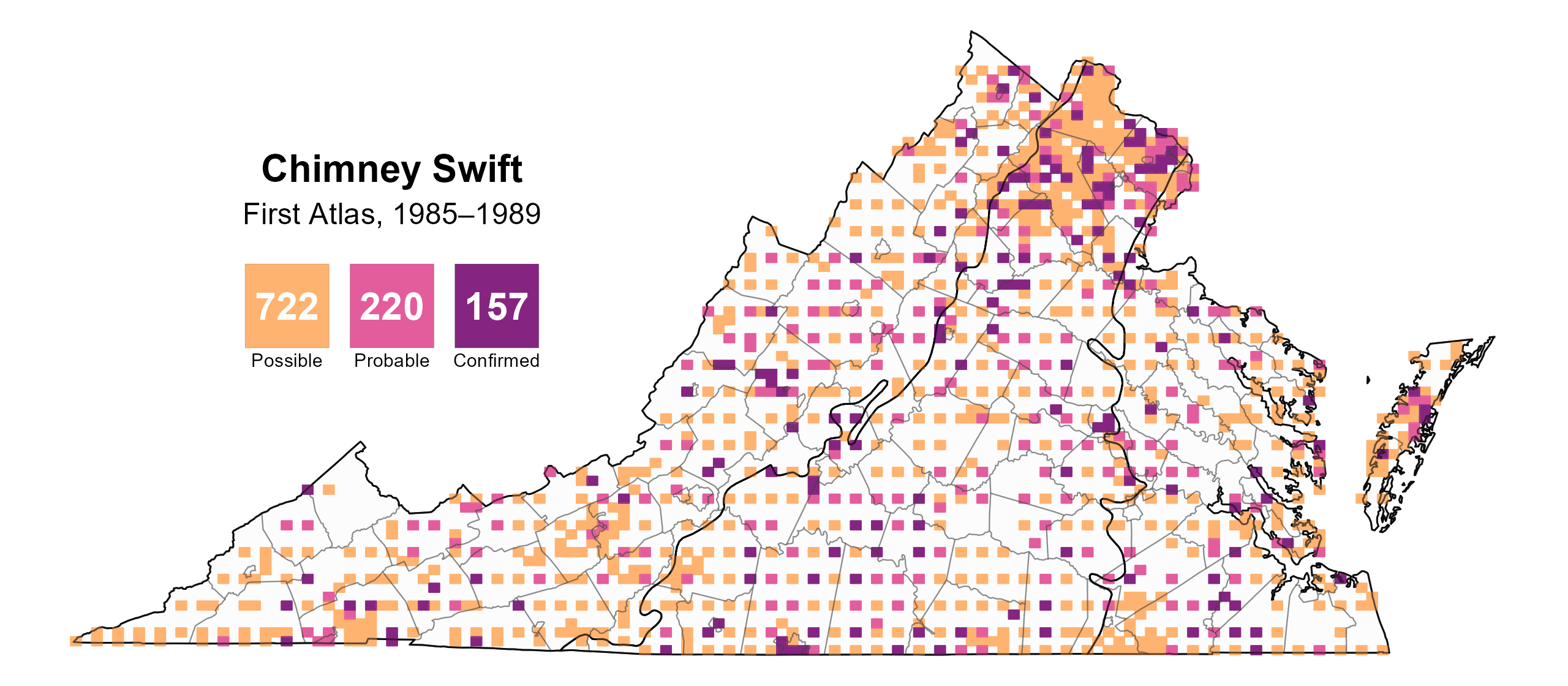
Figure 5: Chimney Swift breeding observations from the First Atlas (1985–1989). The colored boxes illustrate Atlas blocks (approximately 10 mi2 [26 km2] survey units) where the species was detected. The colors show the highest breeding category recorded in a block. The numbers within the colors in the legend correspond to the number of blocks with that breeding evidence category.
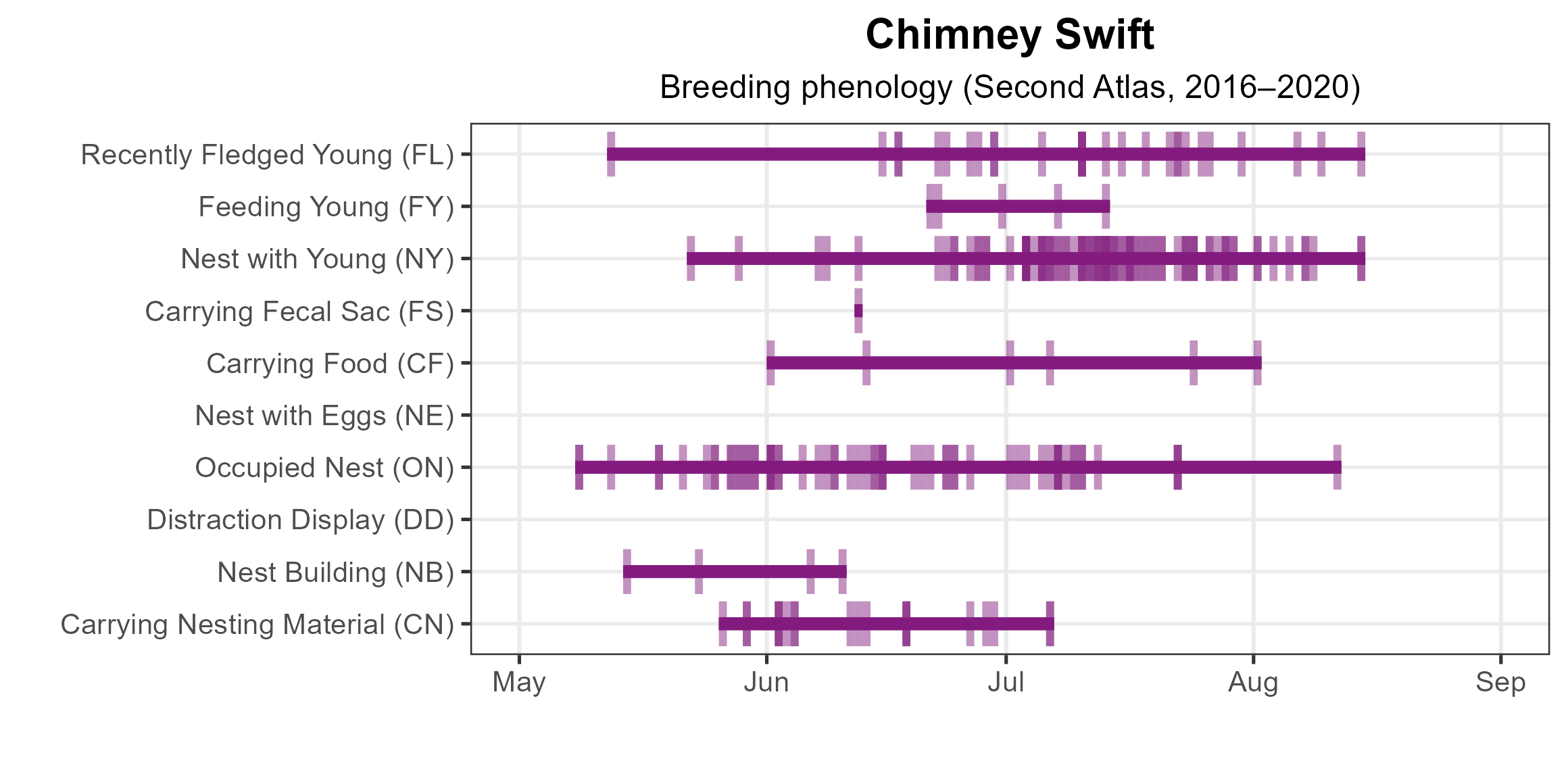
Figure 6: Chimney Swift phenology: confirmed breeding codes. This graph shows a timeline of confirmed breeding behaviors. Tick marks represent individual observations of the behavior.
Population Status
Chimney Swift relative abundance was estimated to be highest near major urban centers and suburban areas, with lower abundance displayed in more rural parts of the state (Figure 7).
The estimated Chimney Swift population in the state is approximately 783,000 individuals (with a range between 620,000 and 989,000). Based on the North American Breeding Bird Survey (BBS), the Chimney Swift population experienced a significant decrease of 1.99% annually from 1966–2022 in Virginia, while the rate of decrease in the population between Atlas periods was even greater at a significant 2.43% per year from 1987–2018 (Hostetler et al. 2023; Figure 7).

Figure 7: Chimney Swift relative abundance (Second Atlas, 2016–2020). This map indicates the predicted abundance of this species at a 0.4 mi2 (1 km2) scale based on environmental (including habitat) factors. Abundance values are presented on a relative scale of low to high.

Figure 8: Chimney Swift population trend for Virginia as estimated by the North American Breeding Bird Survey. The vertical axis shows species abundance; the horizontal axis shows the year. The solid line indicates the estimated population trend; there is a 97.5% probability that the true population trend falls between the dashed lines. The shaded bars indicate the First and Second Atlas periods.
Conservation
Unlike many species of birds, the Chimney Swift appears to have positively adapted to human development. Prior to European settlement, Chimney Swifts nested in large hollow trees, tree cavities, and sometimes caves (Steeves et al. 2020). Soon after European arrival, however, Chimney Swifts quickly adapted to nesting in human-created chimneys, with the earliest record being 1672 (Graves 2004). Today, the species nests almost exclusively in chimneys or other human-created structures.
However, while data are not conclusive, sharp and persistent declines are attributed to a move away from brick chimneys and toward more modern materials that are not suitable for supporting nests (Steeves et al. 2020). Chimney cleaning during the nesting season, which can destroy nests, might also play a role in declining populations. Because of their decline, the 2025 Virginia Wildlife Action Plan includes Chimney Swift as a Tier IV Species of Greatest Conservation Need, indicating that this species is experiencing a significant decline and long-term planning is needed (VDWR 2025).
The Cape Henry Audubon Society is already erecting towers around the state to provide nesting sites for Chimney Swifts to help conserve them.
Interactive Map
The interactive map contains up to six Atlas layers (probability of occurrence for the First and Second Atlases, change in probability of occurrence between Atlases, breeding evidence for the First and Second Atlases, and abundance for the Second Atlas) that can be viewed one at a time. To view an Atlas map layer, mouse over the layer box in the upper left. County lines and physiographic regional boundaries (Mountains and Valleys, Piedmont, and Coastal Plain) can be turned on and off by checking or unchecking the box below the layer box. Within the map window, users can hover on a block to see its value for each layer and pan and zoom to see roads, towns, and other features of interest that are visible beneath a selected layer.
View Interactive Map in Full Screen
References
Graves, G. R. (2004). Avian commensals in colonial America: when did Chaetura pelagica become the Chimney Swift? Archives of Natural History 31:300-307. http://dx.doi.org/10.3366/anh.2004.31.2.300.
Hostetler, J. A., J. R. Sauer, J. E. Hines, D. Ziolkowski, and M. Lutmerding (2023). The North American breeding bird survey, analysis results 1966–2022. U.S. Geological Survey, Laurel, MD, USA. https://doi.org/10.5066/P9SC7T11.
Steeves, T. K., S. B. Kearney-McGee, M. A. Rubega, C. L. Cink, and C. T. Collins (2020). Chimney Swift (Chaetura pelagica), version 1.0. In Birds of the World (A. F. Poole, Editor). Cornell Lab of Ornithology, Ithaca, NY, USA. https://doi.org/10.2173/bow.chiswi.01.
Virginia Department of Wildlife Resources (VDWR). 2025. Virginia wildlife action plan. Virginia Department of Wildlife Resources, Henrico, VA, USA. 506 pp.


